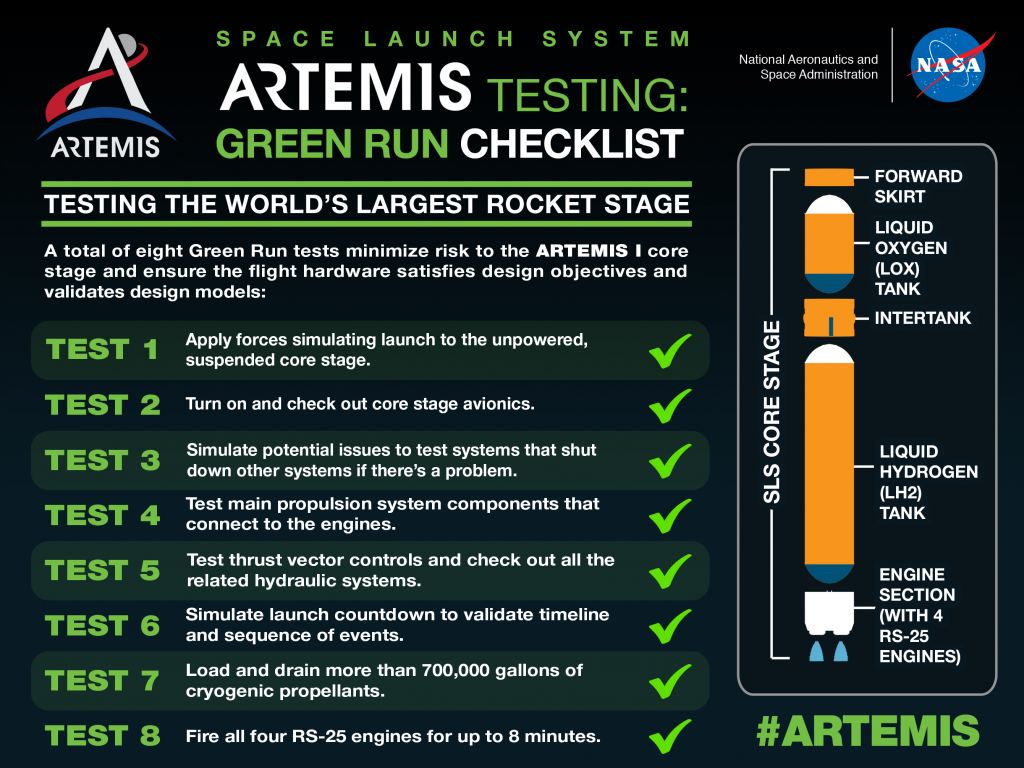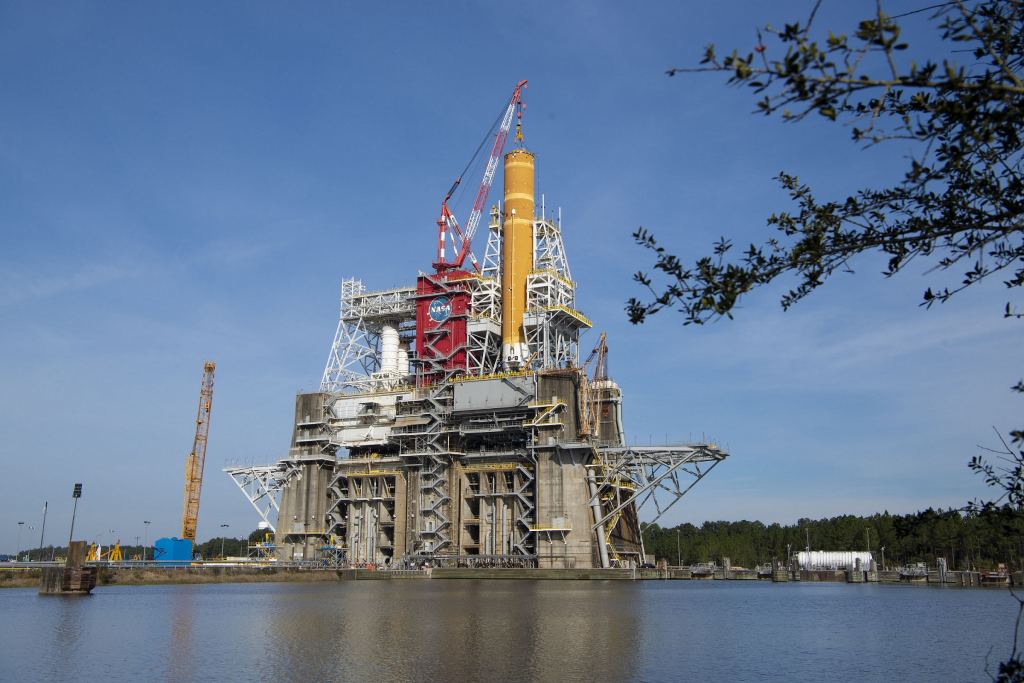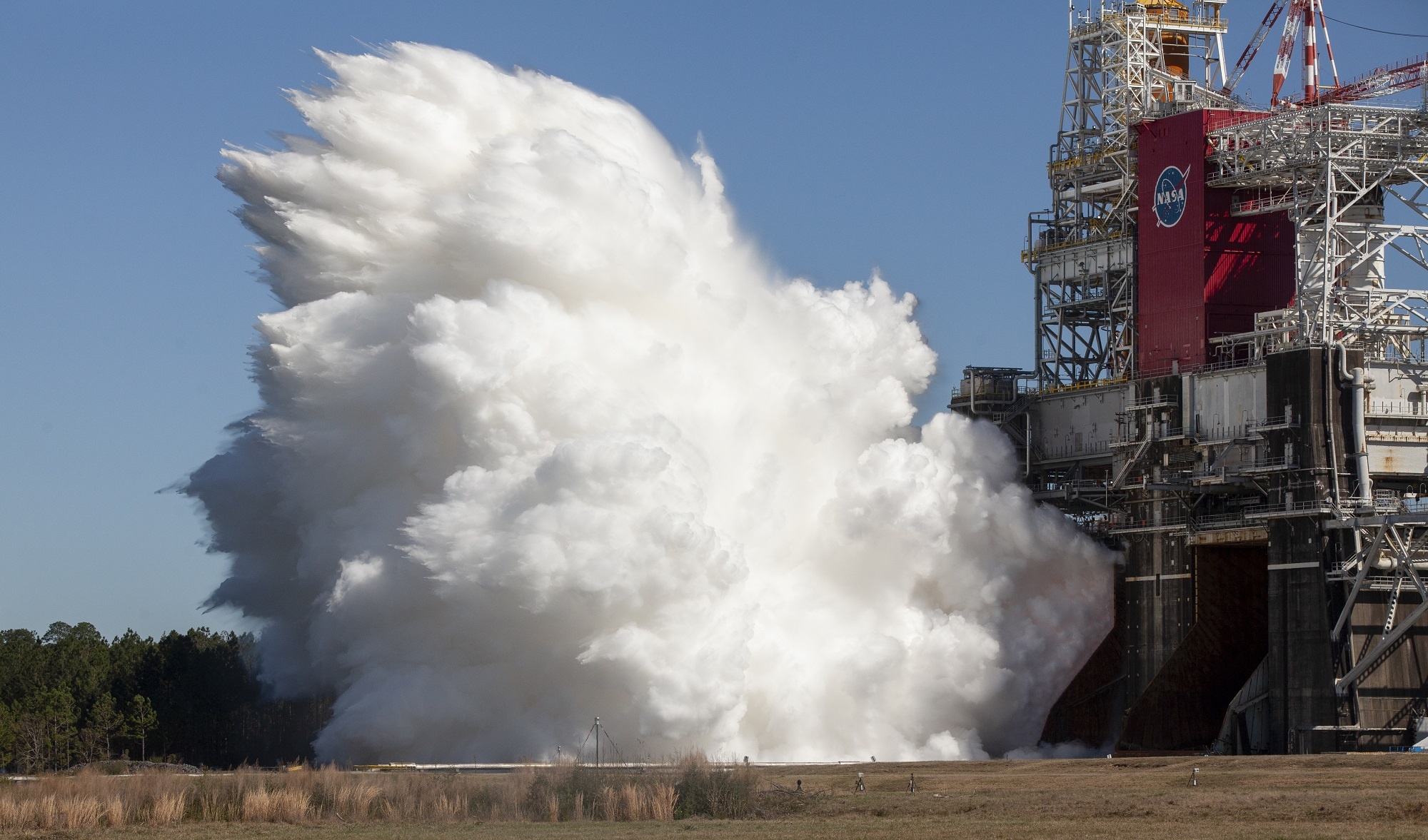When NASA’s Space Launch System (SLS) is fully integrated, assembled, and finished with testing, it will be the most powerful rocket since the Saturn V that carried the Apollo astronauts to the Moon. To get it there, NASA has been conducting a testing campaign known as the Green Run, an 8-step assessment that culminates in a test-firing of all four of the Core’s RS-25 engines (aka. a “Hot Fire” test).
On January 16th, NASA made its first attempt at a Green Run Hot Fire test at the Stennis Space Center’s B-2 Test Stand in Mississippi, which only lasted for about one minute. Another attempt was made on Thursday, March 18th, where all four engines fired for 8 minutes and 19 seconds. This successful fire test is a crucial milestone for the SLS and brings it one step closer to sending astronauts back to the Moon.
During the first attempt, ground controllers at the Stennis Space Center were able to get all four RS-25 engines to fire together for the first time. The test ended after 67.2 seconds when the automated safety systems were tripped, shutting the engines down. This was the result of the test parameters being intentionally conservative to ensure the safety of the Core Stage during the test.
Following an analysis of the test data, NASA determined that a second, longer hot fire test was necessary. On their second attempt, the engines managed to fire for 499 seconds, slightly longer than what is needed to simulate a launch (485 to 493 seconds). Once again, NASA TV provided coverage with a live-broadcast (posted above) which can also be found on the Artemis page at NASA Blogs.
As acting NASA Administrator Steve Jurczyk stated in a subsequent press release:
“The SLS is the most powerful rocket NASA has ever built, and during today’s test the core stage of the rocket generated more than 1.6 million pounds of thrust within seven seconds. The SLS is an incredible feat of engineering and the only rocket capable of powering America’s next-generation missions that will place the first woman and the next man on the Moon. Today’s successful hot fire test of the core stage for the SLS is an important milestone in NASA’s goal to return humans to the lunar surface – and beyond.”
In addition to validating the engines and fuel system, the longer duration hot-fire tested a variety of operational conditions. Notably, the ground crews adjusted the engine nozzles in specific patterns to direct thrust (what is known as a gimbal test) at thirty-second intervals. Meanwhile, the crews also throttled the engines up to 109% power, then back down and up again – something they had been hoping to do back in January.

As John Honeycutt, manager for the SLS Program at NASA’s Marshall Space Flight Center, explained:
“This longer hot fire test provided the wealth of data we needed to ensure the SLS core stage can power every SLS rocket successfully. During this test, the team conducted new operations with the core stage for the first time, repeated some critical operations, and recorded test data that will help us verify the core stage is ready for the first and future SLS flights for NASA’s Artemis program.”
This final leg in the Green Run campaign is also meant to test the SLS Core Stage’s fuel system, which is made up of two propellant tanks that hold more than 2.77 million liters (733,000 gallons). This consists of liquid hydrogen (LH2) and liquid oxygen (LOX) and is then fed to the engines through a long network of pipes and valves. All of this LH2/LOX fuel needs to be pumped in beforehand and creates an extreme pressure situation inside the Core Stage.
The core stage also comes with a complex network of flight software and avionics systems that control the rocket and allow it to collect flight data on the Core Stage and monitor its overall health. Along with the stage’s propulsion and hydraulic systems, these were the subject of previous Green Run tests, which included activating the avionic sensors throughout the stage (Test 2) and testing all the integrated systems with a simulated launch countdown (Test 6).

Said Richard Gilbrech, the Director of NASA’s Stennis Center:
“Today is a great day for NASA, Stennis and this nation’s human space exploration program. This final test in the Green Run series represents a major milestone for this nation’s return to the Moon and eventual mission to Mars. So many people across the agency and the nation contributed to this SLS core stage, but special recognition is due to the blended team of test operators, engineers, and support personnel for an exemplary effort in conducting the test today.”
To get the Core Stage fueled up in time for the test, the teams at Stennis deployed no less than 114 tanker trucks and six propellant barges. During the fire test, the teams monitored the structural interfaces of both the Core Stage and the B-2 Test Stand. They also provided the stand with operational power and more than 1.25 million liters (330,000 gallons) of water per minute to the stand’s flame deflector.
With this final test complete, the core stage is now set to be refurbished and shipped to NASA’s Kennedy Space Center in Florida. Once there, the Core Stage will be assembled with the other parts of the SLS, like the solid rocket boosters that recently finished being stacked at Kennedy. The Orion spacecraft will also be integrated and the whole system will be placed on the mobile launcher inside the Vehicle Assembly Building in preparation for launch.

This mission, Artemis I (currently scheduled for November of 2021), will see an uncrewed Orion spacecraft launched from Launch Complex 39-B at the Kennedy Space Center and fly around the Moon before returning to Earth. Artemis II, scheduled for August of 2023, will be the first crewed mission of the SLS and Orion and will see four astronauts conduct a similar circumlunar flight.
If all goes well, Artemis III and humanity’s long-awaited return to the lunar surface will follow in October of 2024. Combines with the Lunar Gateway, the Artemis Base Camp, and other mission elements, the SLS and Orion will not only usher in a new era of renewed lunar exploration, it will also facilitate future missions to Mars and beyond.
Further Reading: NASA

